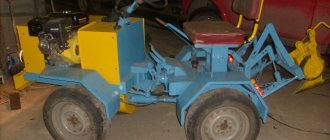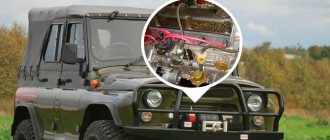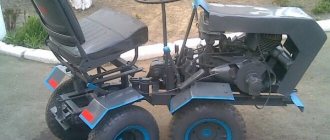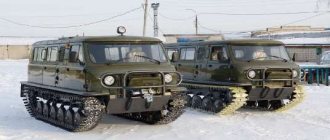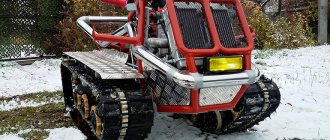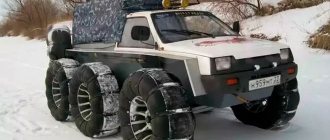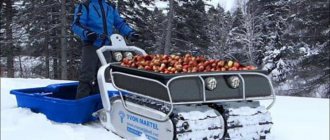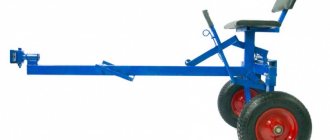Karakat is an all-terrain vehicle with a sectional frame equipped with an articulated joint that allows the halves to deviate in different planes. The equipment has increased cross-country ability, and its simple design allows you to assemble the vehicles yourself using parts from production cars and motorcycles. There are all-terrain vehicles with a fracture-type frame built by small private enterprises.
Advantages and disadvantages of homemade products
The main advantages of the breaking frame technique:
- low cost compared to serial wheeled ATVs;
- positive buoyancy of equipment due to tubes and tires;
- reduced fuel consumption;
- simple design of engine and transmission units.
Disadvantages of homemade or small-scale all-terrain vehicles:
- low reliability of homemade units made from scrap materials without calculating the safety factor;
- insufficient maneuverability and a rigid chassis, which lacks damping units;
- Difficult storage of equipment due to the increased dimensions of the all-terrain vehicle;
- destruction of tire material under the influence of ultraviolet radiation.
Which is better: ATV or caracat
When choosing a karakat or an ATV, it is necessary to take into account the positive and negative aspects of the technology:
- Karakat is equipped with pneumatic tires with increased dimensions, reducing pressure on the ground and providing buoyancy. Tires do not destroy the top layer of soil; ATVs use tires with a rough tread pattern that tears up the turf.
- The ATV is designed to carry a driver and a passenger; caracats are equipped with separate compartments to accommodate 4-6 people and additional luggage.
- Some caracats use liquid-cooled engines, which make it possible to organize a heating circuit for the driver and passenger cabin. On ATVs, electric heating of the handles and seat cushions is provided (optional).
- The maximum speed of the ATV reaches 100 km/h; caracats, due to their design features, accelerate to 50-60 km/h.
The potential buyer needs to know whether the rights to manage the karakat are required.
If the vehicle has a passport, then the document indicates the category of the vehicle; the driver must have a category B or C license (depending on the weight of the vehicle).
Most manufacturers do not prepare documentation for homemade products, so it is impossible to register a karakat without an examination. To ride an ATV, you need a tractor driver's license; registration is carried out on the basis of an official passport.
Homemade caracat from a walk-behind tractor with your own hands
The classic homemade version, when a karakat is made from a walk-behind tractor, can move without problems at speeds below 70 kilometers per hour, which is an excellent indicator for a number of roads with poor surfaces. And if they are absent, such a means of transportation will be simply necessary.
Three-wheel fracture diagram
The unit is able to withstand significant loads, which is facilitated by a fairly strong and reliable suspension, welded from prepared steel pipes. The structure is connected by hinges, which guarantees ease of movement and performance of even the most unusual maneuvers. True, operating this unit requires a certain skill, because the design does not provide for the presence of a worm gear. Below is a typical drawing of a homemade karakat.
Karakat device
The lightweight three-wheeled caracat is built on the basis of a spatial welded frame, equipped with a front single-wheel fork with feather-type shock absorbers and a pair of wheels symmetrically mounted at the rear on axle shafts. Torque from the gearbox is transmitted by a roller chain; there are models with a plug-in drive to the front tire.
Improved caracats are equipped with a sectional frame with a steering knuckle, a spring or spring suspension with additional shock absorbers and travel limiters is provided.
Some machines use a kingpin swivel unit designed for increased loads.
The coupling is characterized by increased requirements for the quality of manufacturing and assembly, and is used on caracats with increased weight and load capacity.
Engine and chassis
The simplest equipment is equipped with motors from Druzhba chainsaws or analogues, but it is better to use engines from agricultural installations or passenger cars. The power is selected depending on the weight of the all-terrain vehicle; there are vehicles with liquid cooling units. Torque is transmitted by a belt or dry clutch with a pedal drive, and the gearbox distributes the power flow between the axles. The differentials in the main pairs are locked, which improves cross-country ability, but worsens handling on hard surfaces.
CVTs
Instead of a stepped gearbox borrowed from AZLK or VAZ cars, a CVT can be used. The transmission includes a reverse mechanism activated by a separate lever. Stepless units provide a smooth change in speed, but are not suitable for use in severe off-road conditions.
Wheels or tracks
There are 2 types of chassis:
- On pneumatic tires made from truck tires by removing part of the cord and cutting off the tread. The resulting parts are characterized by increased elasticity and reduced vibration levels. Some vehicles use tires made to special order (for example, on equipment from the Tyumen Tundra plant).
- On tracks made of rubber conveyor belts. The track rollers are equipped with standard tires from passenger cars (for example, VAZ Priora), the drive wheel is equipped with teeth that engage with metal linings on the belt.
Transport Corps
The body is made of waterproof plywood, the sheets are attached to a metal frame using screws and rivets.
Fenders exposed to wet mud are made of aluminum sheet or fiberglass.
To build amphibians, molded housings made of polyethylene or welded from steel sheets are used; the control outlets are protected with rubber seals.
Other items
The steering is equipped with hydraulic cylinders or a rack mounted across the frame. The hinge allows sections of the half-frame to be tilted left and right; there are vehicles with steered front wheels. The driver is provided with an adjustable seat, passengers sit on hard benches in the luggage compartment. It is possible to install a protective awning or a rigid body with a heater and forced ventilation through sliding windows or a hinged sunroof.
How to adjust valves
The simple design of the ZIS 5 snow and swamp-going vehicle allows you to make changes yourself - for example, adjust valves. The setup is done according to the instructions:
- Using an 8 mm wrench, remove the cap from the cylinder and remove the spark plug.
- Using a 13mm wrench, turn the crankshaft clockwise until both valves are closed.
- Measure the distance between the pusher and the rod with a feeler gauge - the gaps should be 0.05 mm on the intake valve and 0.1 mm on the exhaust valve.
- If there is a discrepancy with the specified clearances, loosen the locknut with a 9 mm wrench and adjust the position of the valves. To reduce the gap, turn the screw clockwise.
- To increase the gap, turn the screw counterclockwise.
Design features
A special feature of the carakat design is its layout, the motor and gearbox are located on the front of the frame. The transfer gearbox transmits torque to the front wheels; a separate shaft running inside the hinge is used to drive the rear wheels. Steering rods are provided, which are attached to hydraulic cylinders or a mechanism, and a standard wheel and pedal assembly are used for control.
Minimum Specifications
Technical parameters of all-terrain vehicles:
- length - from 3000 mm;
- width - from 1500 mm;
- height - from 1200 mm;
- number of passengers - from 4 people;
- load capacity - from 300 kg;
- weight - from 600 kg;
- speed on the highway - from 25 km/h;
- speed on water - from 2 km/h.
Famous models and manufacturers
There are several dozen manufacturers of utilitarian wheeled vehicles with a fracture or monolithic frame. The developers use serial components from passenger cars; frames and cabin elements are made in artisanal conditions. Despite small-scale production, all-terrain vehicles may differ in size and design, which should be taken into account when servicing the equipment.
Velsky Capercaillie
The workshop, located in the city of Velsk, assembles swamp vehicles on a pneumatic chassis under the designation Glukhar. The external panels are made of aluminum sheet coated with a layer of powder paint. The parts are attached to the frame using rivets; the machine is not designed to overcome water obstacles by swimming, but pneumatic wheels provide positive buoyancy. The equipment is equipped with space frames that increase structural rigidity.
Belyaev production
Individual entrepreneur Belyaev manufactures swamp vehicles of the Okhotnik series and supplies lightweight tires to other manufacturers. The chassis is equipped with a Lifan engine that develops a power of 15 hp. s., and a 5-speed synchronized gearbox. The vehicle weighs 600 kg, a soft seat is installed for the driver, and there is no provision for carrying passengers. There is no power steering, the cargo platform is equipped with a lattice fence that allows you to secure luggage with rigging straps.
There is a modification with a frame driver's cabin equipped with canvas flaps and a windshield with an electric wiper.
To heat the internal volume, a flow of warm air from the engine is used. The rear compartment is equipped with benches for 4 passengers and a canvas body, with celluloid windows in the side panels and rear flap.
Swamp rover Aurora
The Aurora swamp vehicle is equipped with a 1-cylinder Lifan gasoline engine with a forced air cooling system. An electric starter is used for starting; the ability to crank the crankshaft manually is retained. The all-terrain vehicle uses treated tubeless tires from a KrAZ truck, and fenders are used to protect the driver and passengers from dirt and splashes. The driver's seat has an adjustable backrest, a windshield and side doors are not provided, the cargo compartment is equipped with hard benches designed for 4 people.
Six-wheeled Taybola
The Taibola amphibian is equipped with lightweight tires and tubes from the GAZ-66, and torque is transmitted by chain drives. In front of the driver there is a windshield in a frame, the doorways are closed with canvas flaps. There are headlights and side lights that increase operating safety in poor visibility conditions. Lifan or SZD gasoline units are used as the power plant, developing power up to 18 hp. With.
All-terrain vehicles from Pavel Asterix
The private workshop of Pavel Asterix offers custom assembly of wheeled off-road vehicles. After assembly, the machines undergo a test cycle and are run in; the warranty period is 3 months. The production is located in the north-west of the Tver region, the manufacturer offers snowmobiles with a space frame or with articulated sections welded from a steel profile.
Swamp walker Maple
Klen brand swamp vehicles are assembled by a private craftsman based on an in-line 4-cylinder VAZ-21114 engine with a gasoline injection system and transmission units from UAZ SUVs. The ladder frame and spring suspension were borrowed from the cars of the Ulyanovsk Automobile Plant.
The closed body is designed for a driver and 4 passengers, there is a heating system from the engine radiator.
The interior of the all-terrain vehicle has an instrument panel with control indicators, a sealed cabin and low-pressure tires provide the vehicle with positive buoyancy.
Model Ural
The Ural model is based on the power unit of a heavy motorcycle; torque is transmitted to the gearbox from a Zhiguli car, which is connected to the rear axle by a driveshaft. The space frame is made of steel pipes, the fuel supply is in the motorcycle tank. The front wheel hubs are mounted on a homemade wishbone suspension with leaf springs, and there is no power steering. The driver is protected from dirt by a windshield and fenders made of sheet steel; there are no seats for passengers.
Alligator on caterpillars
The Alligator tracked snowmobile is equipped with a 50-horsepower Lebedev Motors Lm800 engine with a liquid cooling system. The sealed polyethylene body is designed to carry 6 passengers or up to 500 kg of cargo (on land, on water the parameter drops to 400 kg), the vehicle is capable of swimming across water obstacles.
The installation of an electric traction winch and a pump for pumping water out of the hull is provided.
The transmission includes a single-row V-belt variator with additional reduction speed and differential lock.
White Kholunitsa
A private craftsman built several wheeled all-terrain vehicles under the Belaya Kholunitsa brand; the design used a homemade frame with a hinge unit. The equipment was intended for movement on snow-covered roads and wetlands, and it was possible to tow a trailer on wheels or skis. As of spring 2022, assembly and technical support have been discontinued, and the manufacturer’s contacts are not publicly available.
From Uvata
Uvat wheeled vehicles are produced by a small Omsk company based on the engine and gearbox from the VAZ-2109 and chassis units from Mitsubishi SUVs. The installation of pneumatic differential locks is provided, and the steering has a hydraulic booster. The fuel tank holds up to 150 liters of gasoline, and an electric pump is provided to supply fuel. The cabin and cargo compartment are made of aluminum sheet with insulation; there is a voltage converter for switching household equipment.
Model Jaeger
The Vologda swamp rover Jaeger is produced in several modifications:
- The basic version is equipped with a Lifan engine with an electric starter and a gearbox from Lada cars with front drive wheels. The brakes and clutch are equipped with hydraulic drives, and the engine compartment is protected. The driver's seat is adjustable to suit the person's height, and there are signs on the instrument panel with a detailed description of the control algorithm.
- A modification with an awning over the driver's seat and windshield; the cargo-passenger compartment has no protection from precipitation. Fenders are installed above the front tires, and a hinged door is provided at the rear of the cargo compartment.
- The Topol version is distinguished by the installation of an improved engine and electric power steering (a hydraulic drive is available upon request). The differential in the gearbox is locked, the length of the passenger compartment is increased by 170 mm. The equipment is built to order; the manufacturer offers several types of engines with power from 27 to 35 hp. With. the buyer himself determines which engine will be installed on the car.
Swamp walker Cuttlefish
The utilitarian swamp vehicle Cuttlefish is equipped with a 1-cylinder 4-stroke engine; the design uses a standard clutch from a VAZ car; a belt drive is provided between the gearbox and the engine. The axle stockings are rigidly welded to the frame, and hydraulic brakes are provided.
The manufacturer does not install the cabin, allowing owners to modify the design themselves.
The cargo platform made of multi-layer plywood is equipped with side seats designed for 2-3 passengers (total capacity from 4 to 6 people).
All-terrain vehicle Bubble
The floating vehicle Bubble, equipped with a breaking point on the frame, is designed for transporting people and cargo in off-road conditions. The driver and passenger sit in a closed cabin, the engine and gearbox are covered with a hood. A headlight and side lighting are provided, and a starter is used to start the gasoline engine. Rotation of the steering wheel allows you to fold sections of the frame; low-pressure tires have a developed tread pattern.
Swamp walker Burlak
The six-wheeled all-terrain vehicle of the Burlak series was developed by engineer and traveler Alexei Makarov; the equipment is designed for operation in permafrost conditions. A 150-horsepower Cummins 2.8 ISF diesel engine is used as a power unit; a liquid heater with a timer is installed. A closed body made of aluminum sheet with additional insulation has seats in front for two people, the steering is equipped with a power amplifier and a damper. A voltage converter is provided for connecting household equipment.
Dimensions and main characteristics of the all-terrain vehicle:
- body length - 7380 mm;
- width - 2900 mm;
- height - 3200 mm;
- disc mounting diameter - 32″;
- tire size - 1750x750 mm;
- weight of the loaded machine - 7000 kg;
- speed - up to 80 km/h.
Vologda Favorite
The Favorite wheeled snowmobile is equipped with a 1-cylinder engine with a power of 17 hp or more. and a manual transmission from the “classic” VAZ models. The basic modification is equipped with a monolithic frame; the chassis includes axles with a conical main pair and a differential. The plant offers vehicles with an additional transfer gearbox from the VAZ-21213, which expands the capabilities of the power unit; the hubs are equipped with tires made from KamAZ and URAL truck tires.
On the Favorite Zero modification, a breakable unit is located between the sections of the steel profile frame; for control, a rack and pinion mechanism and a steering wheel located on a column from a VAZ-2108 car are used. The best and most expensive version of the Arch is equipped with a 2-cylinder liquid-cooled engine and a dry clutch with a hydraulic drive. The driving beams have a dependent spring suspension with shock absorbers, the cabin of a sealed design is equipped with forced ventilation and heating.
ZiS
The utilitarian ZiS waterfowl equipment is assembled by a private workshop from Vologda; the machine is based on a steel frame and two drive axles from a VAZ car. The manufacturer has provided for the installation of a hydraulic braking system, the dry weight is 410 kg, the design can withstand loads of up to 500 kg. The gasoline engine is equipped with an electric starter and a generator that supports the operation of side lighting. To protect passengers from dirt, wings and shelves are used on the sides of the cargo compartment; the engine is covered with a decorative fiberglass hood.
Bobik 4x4
The Bobik 4x4 swamp vehicle on low-pressure tires is equipped with a steel frame with a steering knuckle from the front axle of a UAZ vehicle. The design uses an 11-horsepower Lifan 182FD engine and a 4-speed gearbox from a VAZ-2106. The hinge is attached to a sheet steel plate welded to the end surface of the frame; a drive shaft passes inside the assembly. A belt clutch is used to transmit torque from the crankshaft; the equipment is designed to transport a driver and 4 passengers at speeds of up to 25 km/h on dirt or deep snow.
Model Pathfinder
The Pathfinder model, manufactured by the private company Vezdekhodoff from Vologda, is equipped with low-pressure pneumatics and a Chinese air-cooled Lifan engine. The basic version is equipped with a driver's seat, the improved version is equipped with a cargo platform designed to carry four passengers. A closed cabin is not used, which improves visibility from the driver's seat; bent fenders are used to protect people from dirt. A pivot-type fracture unit is provided on the frame; automobile axles without suspension are used in the chassis.
All-terrain vehicle Lesnik
Vologda wheeled all-terrain vehicles Lesnik are equipped with tires with a diameter of 1300 or 1600 mm. The equipment is equipped with a closed aluminum monocoque body; there are modifications with 4 and 6 wheels. The manufacturer uses gasoline engines with distributed injection, borrowed from VAZ passenger cars; versions with a Kubota diesel engine equipped with a turbocharger are offered.
The advantage of the technology is the leaf spring suspension from UAZ SUVs; the steering features a volumetric hydraulic booster. The manufacturer offers the installation of drive axles from a GAZ-66 truck; upon request, imported Volvo Laplander units are installed, ensuring an increase in the ground clearance of the snow and swamp-going vehicle to 720 mm. The fuel supply is stored in 2 tanks, the interior is designed to carry 8 people, and there is a towing hook for installing a wheeled trailer.
Other manufacturers
The Veps company offers several types of wheeled vehicles with open cabins; upon request, a light canopy is installed over the driver’s seat and a windshield is installed. The transmission includes a variator with a reverse gearbox and a transfer case with a center differential lock. The machine can overcome water obstacles by swimming; movement is carried out by rotating the drive wheels (speed on water is up to 2-3 km/h).
Workshop Dobrynya offers Safari amphibians on a tracked chassis with road wheels equipped with pneumatic tires. The caterpillar is made of rubber, equipped with metal spurs and teeth that prevent the tape from coming off when turning. Basic models are equipped with a windshield; there are modifications with a lightweight closed body. The Vologda company All-terrain vehicles assembles BMP and BMG models equipped with wheeled or tracked chassis and Chinese Lifan power units.
Improvements
The Vologda Caracat ZIS 5 can be easily modified to suit your requirements. The most common types of alterations are:
- Installing a steering damper to make driving the all-terrain vehicle easier.
- Strengthening the frame so that the ZIS can be used in more extreme conditions.
- Installation of a windshield and awning if you need to use an all-terrain vehicle in winter.
- Equipped with a trailer hitch and towing eye to allow you to carry more cargo.
- Install halogen or LED headlights to use the ZIS 5 in the dark.
- Installing a softer seat with a shock absorber if you need to spend a lot of time on the all-terrain vehicle.
Finding suitable components for the ZIS 5 is not difficult. Parts from the VAZ 2105, as well as all-terrain vehicles Vepr, Okhotnik and Taiga are suitable for the car.
